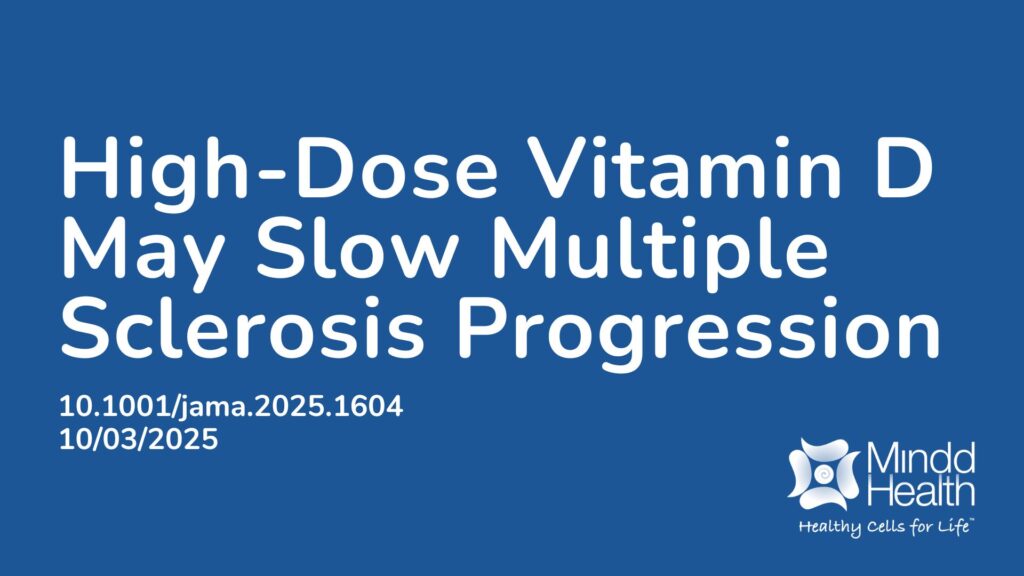Summary:
This clinical trial looked at whether high-dose vitamin D could reduce disease activity in people with early signs of multiple sclerosis (MS). The trial involved 303 participants aged 18 to 55 who had been diagnosed with clinically isolated syndrome (CIS), which is often a precursor to MS. At the onset of the study, the participants had low vitamin D levels and had not yet started any MS treatment. The participants received either vitamin D (treatment group) or a placebo (control group) for two years. Those in the treatment group took 100,000 IU of vitamin D every two weeks. The results showed that 60.3% of the treatment group experienced disease activity compared to 74.1% of the placebo group. MRI scans revealed fewer new and active lesions in those taking vitamin D. However, the number of relapses was not significantly different between groups. These findings suggest that high-dose vitamin D may slow disease progression in people with early MS, including relapses or new lesions on MRI scans, compared to those who took the placebo.
Abstract:
Importance: Vitamin D deficiency is a risk factor for multiple sclerosis (MS) and is associated with the risk of disease activity, but data on the benefits of supplementation are conflicting. Objective To evaluate the efficacy of high-dose cholecalciferol as monotherapy in reducing disease activity in patients with clinically isolated syndrome (CIS) typical for MS. Design, Setting, and Participants: The D-Lay MS trial was a parallel, double-blind, randomized placebo-controlled clinical trial in 36 MS centers in France. Patients were enrolled from July 2013 to December 2020 (final follow-up on January 18, 2023). Untreated patients with CIS aged 18 to 55 years with CIS duration less than 90 days, serum vitamin D concentration less than 100 nmol/L, and diagnostic magnetic resonance imaging (MRI) meeting 2010 criteria for dissemination in space or 2 or more lesions and presence of oligoclonal bands were recruited. Intervention Patients were randomized 1:1 to receive oral cholecalciferol 100 000 IU (n = 163) or placebo (n = 153) every 2 weeks for 24 months. Main Outcomes and Measures: The primary outcome measure was disease activity, defined as occurrence of a relapse and/or MRI activity (new and/or contrast-enhancing lesions) over 24 months of follow-up, also analyzed as separate secondary outcomes. Results: Of the 316 participants enrolled and randomized (median [IQR] age, 34 [28-42] years; 70% women), the primary analysis included 303 patients (95.9%) who took at least 1 dose of the study drug and 288 (91.1%) ultimately completed the 24-month trial. Disease activity was observed in 94 patients (60.3%) in the vitamin D group and 109 patients (74.1%) in the placebo group (hazard ratio [HR], 0.66 [95% CI, 0.50-0.87]; P = .004), and median time to disease activity was longer in the vitamin D group (432 vs 224 days; log-rank P = .003). All 3 secondary MRI outcomes reported significant differences favoring the vitamin D group vs the placebo group: MRI activity (89 patients [57.1%] vs 96 patients [65.3%]; HR, 0.71 [95% CI, 0.53-0.95]; P = .02), new lesions (72 patients [46.2%] vs 87 patients [59.2%]; HR, 0.61 [95% CI, 0.44-0.84]; P = .003), and contrast-enhancing lesions (29 patients [18.6%] vs 50 patients [34.0%]; HR, 0.47 [95% CI, 0.30-0.75]; P = .001). All 10 secondary clinical outcomes showed no significant difference, including relapse, which occurred in 28 patients (17.9%) in the vitamin D group vs 32 (21.8%) in the placebo group (HR, 0.69 [95% CI, 0.42-1.16]; P = .16). Results were similar in a subset of 247 patients meeting updated 2017 diagnostic criteria for relapsing-remitting MS at treatment initiation. Severe adverse events occurred in 17 patients in the vitamin D group and 13 in the placebo group, none of which were related to cholecalciferol. Conclusions and Relevance: Oral cholecalciferol 100 000 IU every 2 weeks significantly reduced disease activity in CIS and early relapsing-remitting MS. These results warrant further investigation, including the potential role of pulse high-dose vitamin D as add-on therapy.
Article Publication Date: 10/03/2025
DOI: 10.1001/jama.2025.1604



